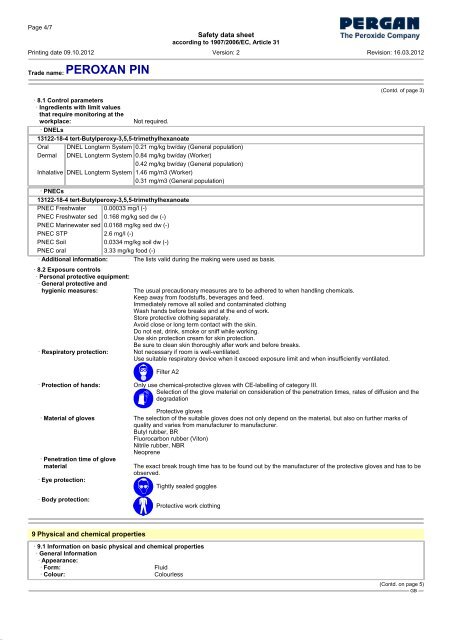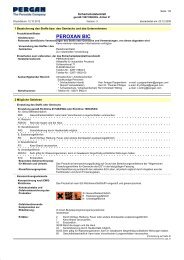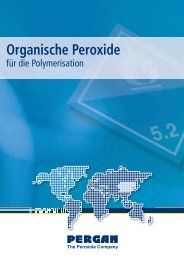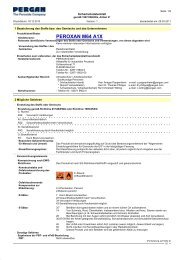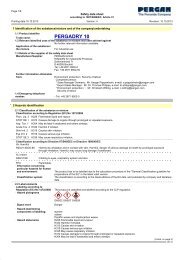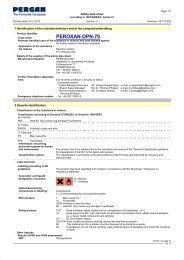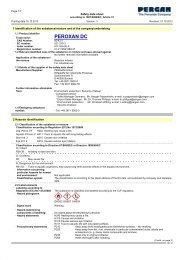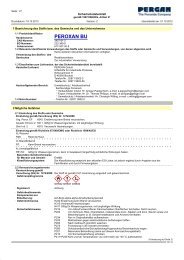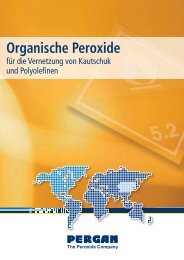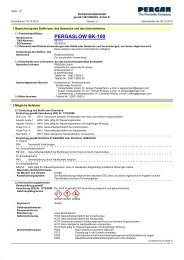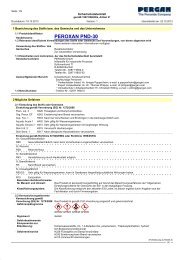PEROXAN PIN - Pergan GmbH
PEROXAN PIN - Pergan GmbH
PEROXAN PIN - Pergan GmbH
You also want an ePaper? Increase the reach of your titles
YUMPU automatically turns print PDFs into web optimized ePapers that Google loves.
35.0.31<br />
Page 4/7<br />
Printing date 09.10.2012<br />
Safety data sheet<br />
according to 1907/2006/EC, Article 31<br />
Version: 2<br />
Revision: 16.03.2012<br />
Trade name: <strong>PEROXAN</strong> <strong>PIN</strong><br />
· 8.1 Control parameters<br />
· Ingredients with limit values<br />
that require monitoring at the<br />
workplace: Not required.<br />
· DNELs<br />
13122-18-4 tert-Butylperoxy-3,5,5-trimethylhexanoate<br />
Oral DNEL Longterm System 0.21 mg/kg bw/day (General population)<br />
Dermal DNEL Longterm System 0.84 mg/kg bw/day (Worker)<br />
0.42 mg/kg bw/day (General population)<br />
Inhalative DNEL Longterm System 1.46 mg/m3 (Worker)<br />
0.31 mg/m3 (General population)<br />
· PNECs<br />
13122-18-4 tert-Butylperoxy-3,5,5-trimethylhexanoate<br />
PNEC Freshwater 0.00033 mg/l (-)<br />
PNEC Freshwater sed 0.168 mg/kg sed dw (-)<br />
PNEC Marinewater sed 0.0168 mg/kg sed dw (-)<br />
PNEC STP 2.6 mg/l (-)<br />
PNEC Soil 0.0334 mg/kg soil dw (-)<br />
PNEC oral 3.33 mg/kg food (-)<br />
· Additional information: The lists valid during the making were used as basis.<br />
· 8.2 Exposure controls<br />
· Personal protective equipment:<br />
· General protective and<br />
hygienic measures: The usual precautionary measures are to be adhered to when handling chemicals.<br />
Keep away from foodstuffs, beverages and feed.<br />
Immediately remove all soiled and contaminated clothing<br />
Wash hands before breaks and at the end of work.<br />
Store protective clothing separately.<br />
Avoid close or long term contact with the skin.<br />
Do not eat, drink, smoke or sniff while working.<br />
Use skin protection cream for skin protection.<br />
Be sure to clean skin thoroughly after work and before breaks.<br />
· Respiratory protection: Not necessary if room is well-ventilated.<br />
Use suitable respiratory device when it exceed exposure limit and when insufficiently ventilated.<br />
`Q<br />
Filter A2<br />
(Contd. of page 3)<br />
· Protection of hands: Only use chemical-protective gloves with CE-labelling of category III.<br />
Selection of the glove material on consideration of the penetration times, rates of diffusion and the<br />
degradation<br />
`S<br />
Protective gloves<br />
· Material of gloves The selection of the suitable gloves does not only depend on the material, but also on further marks of<br />
quality and varies from manufacturer to manufacturer.<br />
Butyl rubber, BR<br />
Fluorocarbon rubber (Viton)<br />
Nitrile rubber, NBR<br />
Neoprene<br />
· Penetration time of glove<br />
material The exact break trough time has to be found out by the manufacturer of the protective gloves and has to be<br />
observed.<br />
· Eye protection:<br />
Tightly sealed goggles<br />
· Body protection:<br />
`R<br />
9 Physical and chemical properties<br />
Protective work clothing<br />
· 9.1 Information on basic physical and chemical properties<br />
· General Information<br />
· Appearance:<br />
· Form: Fluid<br />
· Colour: Colourless<br />
(Contd. on page 5)<br />
GB


